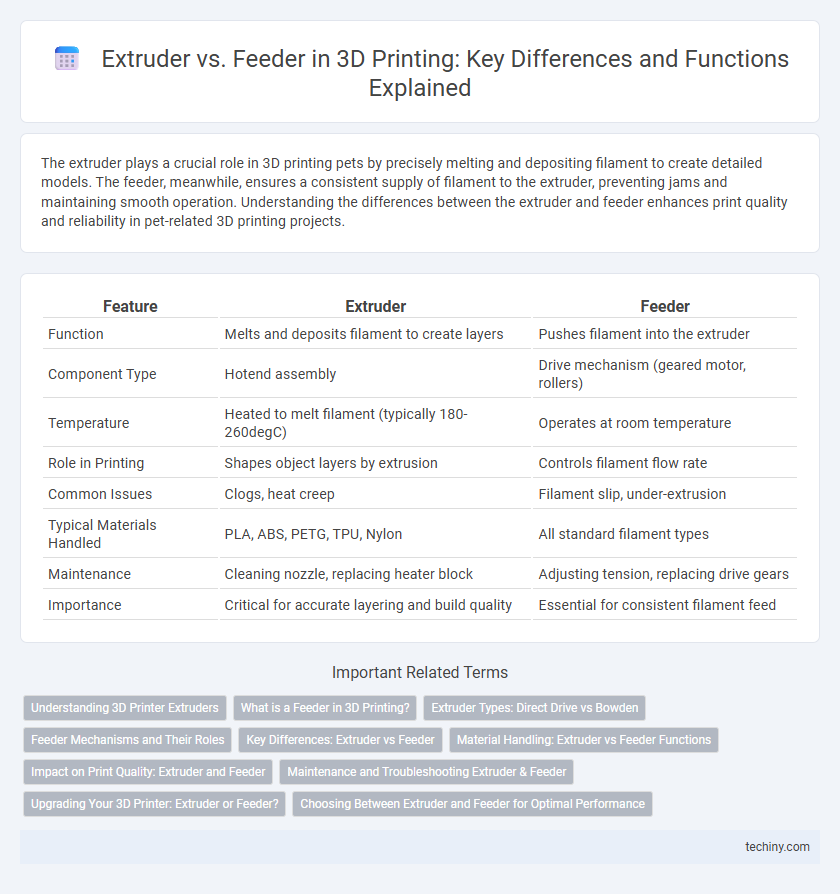The extruder plays a crucial role in 3D printing pets by precisely melting and depositing filament to create detailed models. The feeder, meanwhile, ensures a consistent supply of filament to the extruder, preventing jams and maintaining smooth operation. Understanding the differences between the extruder and feeder enhances print quality and reliability in pet-related 3D printing projects.
Table of Comparison
| Feature | Extruder | Feeder |
|---|---|---|
| Function | Melts and deposits filament to create layers | Pushes filament into the extruder |
| Component Type | Hotend assembly | Drive mechanism (geared motor, rollers) |
| Temperature | Heated to melt filament (typically 180-260degC) | Operates at room temperature |
| Role in Printing | Shapes object layers by extrusion | Controls filament flow rate |
| Common Issues | Clogs, heat creep | Filament slip, under-extrusion |
| Typical Materials Handled | PLA, ABS, PETG, TPU, Nylon | All standard filament types |
| Maintenance | Cleaning nozzle, replacing heater block | Adjusting tension, replacing drive gears |
| Importance | Critical for accurate layering and build quality | Essential for consistent filament feed |
Understanding 3D Printer Extruders
3D printer extruders are critical components responsible for precisely melting and depositing filament material layer by layer to create accurate prints. The extruder comprises a motor-driven feeder mechanism that pushes the filament into a heated nozzle, ensuring consistent flow and pressure during printing. Understanding the differences between the extruder's hot end and the feeder mechanism helps optimize print quality and troubleshoot common printing issues like clogging or under-extrusion.
What is a Feeder in 3D Printing?
A feeder in 3D printing is a mechanical component that pushes the filament into the extruder, ensuring consistent material flow. It typically uses gears or a drive mechanism to grip and advance the filament with precise control. By regulating filament movement, the feeder plays a critical role in preventing jams and maintaining print quality.
Extruder Types: Direct Drive vs Bowden
Direct drive extruders position the motor directly on the print head, enabling precise filament control and better performance with flexible materials. Bowden extruders use a remote motor feeding filament through a long tube, reducing the moving mass and increasing print speed but sometimes compromising retraction and flexibility handling. Understanding the mechanical differences between direct drive and Bowden setups is essential for optimizing print quality and material compatibility in 3D printing.
Feeder Mechanisms and Their Roles
Feeder mechanisms in 3D printing are responsible for pushing the filament into the extruder with consistent pressure, ensuring smooth material flow during the printing process. These feeders can be direct drive or Bowden types, each affecting print quality and speed differently by controlling filament feed accuracy and retraction capabilities. Optimizing feeder performance reduces issues such as filament grinding and clogging, directly enhancing print reliability and surface finish.
Key Differences: Extruder vs Feeder
The extruder in 3D printing is responsible for melting and depositing filament through a hotend, whereas the feeder mechanically pushes the filament towards the extruder. The feeder's primary role is to ensure consistent filament supply and tension, optimizing print quality and preventing jams. Understanding the distinction between extruder components enhances printer maintenance and troubleshoot filament feed issues.
Material Handling: Extruder vs Feeder Functions
The extruder is responsible for melting and precisely depositing filament material layer by layer during the 3D printing process, ensuring accurate flow and temperature control. The feeder mechanism's primary function is to push the filament consistently into the extruder, handling material feed rate and preventing jams or slippage. Together, the extruder and feeder coordinate to optimize material handling, maintaining print quality and mechanical reliability.
Impact on Print Quality: Extruder and Feeder
The extruder directly influences print quality by controlling the precise melting and deposition of filament, ensuring consistent layer adhesion and detail resolution. The feeder's role in maintaining steady filament supply reduces the risk of under-extrusion or clogging, which can cause gaps and weak points in prints. Optimal coordination between extruder and feeder is essential for achieving high-quality 3D prints with smooth surfaces and accurate dimensional fidelity.
Maintenance and Troubleshooting Extruder & Feeder
Regular maintenance of the extruder and feeder in 3D printers is crucial for optimal performance and print quality. Cleaning the extruder nozzle to prevent clogs and checking the feeder gears for filament debris ensures smooth filament flow and reduces print failures. Troubleshooting common issues involves inspecting the extruder's heating element and thermistor for consistent temperature control and verifying the feeder motor's functionality to avoid filament jams or skipping.
Upgrading Your 3D Printer: Extruder or Feeder?
Upgrading your 3D printer involves choosing between enhancing the extruder or the feeder system, each impacting print quality and reliability. An advanced extruder improves filament melting and flow precision, ideal for complex prints and diverse materials, while a high-quality feeder ensures consistent filament tension and reduces jams, crucial for smooth operation. Prioritize based on printing demands: extruder upgrades suit detailed, high-temperature prints; feeder upgrades benefit high-speed or flexible filament usage.
Choosing Between Extruder and Feeder for Optimal Performance
Choosing between an extruder and feeder is crucial for optimal 3D printing performance; extruders control filament melting and deposition while feeders regulate filament flow rate and pressure. High-precision 3D prints require extruders with reliable thermal control and consistent nozzle output, whereas feeders must offer smooth, jam-free filament feeding to maintain print quality. Selecting components compatible with specific filament types and printer models enhances overall efficiency and print accuracy.
Extruder vs Feeder Infographic

 techiny.com
techiny.com